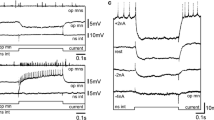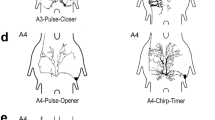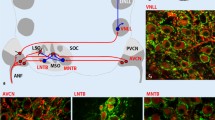Summary
-
1.
The two largest interneurons in the abdominal nervous system of crickets (the Medial and Lateral Giant Interneurons, MGI and LGI) have been studied using intracellular and extracellular recording techniques and cobalt filling.
-
2.
All of the largest action potentials (5–7mV) seen in the extracellularly recorded phasic response of the connectives anterior to the terminal abdominal ganglion to sound stimulation can be accounted for by the behavior of MGI and LGI. In favorable preparations the action potentials of the two cells can be discriminated from each other on the basis of amplitude, LGI potentials being up to 30% greater than those of MGI.
-
3.
The thresholds of the two cells to sound stimulation are similar, but the intensity response curve of MGI rises relatively steeply while that of LGI rises slowly and may saturate at levels as low as two spikes per response. At moderate sound intensities (e.g. 80 dB) MGI produces the majority of giant action potentials.
-
4.
Both neurons are directionally sensitive to tones. In the horizontal plane they respond maximally when the stimulus is positioned transversely to the cercus ipsilateral to the axon of the interneuron. Directional sensitivity diagrams in three dimensions are presented.
-
5.
Both interneurons exhibit similar frequency response curves and are maximally sensitive to 500 Hz tones.
Similar content being viewed by others
References
Bentley, D.: Single gene cricket mutations: Effects on behavior, sensilla, sensory neurons and identified interneurons. Science187, 760–764 (1975)
Bischof, H.-J.: Verteilung und Bewegungsweise der keulenförmigen Sensillen vonGryllus bimaculatus Deg. Biol. Zbl.93, 449–457 (1974)
Bischof, H.-J.: Die keulenförmigen Sensillen auf den Cerci der GrilleGryllus bimaculatus als Schwererezeptoren. J. comp. Physiol.98, 277–288 (1975)
Edwards, J.S., Palka, J.: The cerci and abdominal giant fibres of the house cricket,Acheta domesticus. I. Anatomy and physiology of normal adults. Proc. Roy. Soc. Lond. B185, 83–103 (1974)
Huber, F.: Brain controlled behavior in orthopterans. In: The physiology of the insect nervous system (eds. J.E. Treherne, J.W.L. Beament), pp. 233–256. London-New York: Academic Press 1965
Langberg, J.J., Westin, J., Camhi, J.M.: Response of giant axons of the cockroach (Periplaneta americana) to wind from different directions. Soc. Neurose. Abstr. (1976)
Markl, H.: Leistungen des Vibrationssinnes bei wirbellosen Tieren. Fortschr. Zool.21, 100–120 (1973)
Markl, H., Tautz, J.: The sensitivity of hair receptors in caterpillars ofBarathra brassicae L. (Lepidoptera, Noctuidae) to particle movement in a sound field. J. comp. Physiol.99, 79–87 (1975)
Matsumoto, S.G., Murphey, R.K.: The cercus-to-giant interneuron system of crickets. IV. Patterns of connectivity between receptors and the medial giant interneuron. J. comp. Physiol.119, 319–330 (1977)
Mendenhall, B., Murphey, R.K.: The morphology of cricket giant interneurons. J. Neurobiol.5, 565–580 (1974)
Michelsen, A., Nocke, H.: Biophysical aspects of sound communication in insects. Adv. Insect Physiol.9, 247–296 (1974)
Murphey, R.K.: Characterization of an insect neuron which cannot be visualized in situ. In: Intracellular staining techniques in neurobiology (eds. S.B. Kater, C. Nicholson), pp. 135–150 Berlin-Heidelberg-New York: Springer 1973
Murphey, R.K., Matsumoto, S.G.: Experience modifies the plastic properties of identified neurons. Science191, 564–566 (1976)
Nicklaus, R.: Die Erregung einzelner Fadenhaare vonPeriplaneta americana in Abhängigkeit von der Größe und Richtung der Auslenkung. Z. vergl. Physiol.50, 331–362 (1965)
Palka, J., Edwards, J.S.: The cerci and abdominal giant fibres of the house cricket,Acheta domesticus. II. Regeneration and effects of chronic deprivation. Proc. Roy. Soc. Lond. B185, 105–121 (1974)
Palka, J., Levine, R., Schubiger, M.: The cercus-to-giant interneuron system of crickets. I. Some attributes of the sensory cells. J. comp. Physiol.119, 267–283 (1977)
Palka, J., Olberg, R.: The cercus-to-giant interneuron system of crickets. III. Receptive field organization. J. comp. Physiol.119, 301–317 (1977)
Palka, J., Schubiger, M.: Central connections of receptors on rotated and exchanged cerci of crickets. Proc. Nat. Acad. Sci. U.S.A.72, 966–969 (1975)
Parnas, I., Dagan, D.: Functional organization of giant axons in the central nervous systems of insects: New aspects. Adv. Insect Physiol.8, 95–144 (1971)
Payne, R.S., Roeder, K.D., Wallman, J.: Directional sensitivity of the ears of noctuid moths. J. Exp. Biol.44, 17–31 (1966)
Petrovskaya, E.D.: On frequency selectivity of cereal trichoid receptors in the cricketGryllus domesticus. Zh. Evol. Biokhim. Fiziol.5, 337–338 (1969)
Petrovskaya, E.D., Kaplan, V.I., Losev, N.I., Rozhkova, G.I.: Measurement of acoustic thresholds in the cricketGryllus domesticus. Zh. Evol. Biokhim. Fiziol.6, 644–646 (1970)
Petrovskaya, E.D., Rozhkova, G.I., Tokareva, V.S., Etkin, V.S.: Properties and receptive fields of the central neurones of the cereal auditory system of the cricket. Biofizika14, 545–552 (1969)
Pumphrey, R.J., Rawdon-Smith, A.F.: Hearing in insects: The nature of the response of certain receptors to auditory stimuli. Proc. Roy. Soc. Lond. B121, 18–27 (1936)
Roeder, K.D.: Auditory system of noctuid moths. Science154, 1515–1521 (1966)
Tokareva, V.S., Rozhkova, G.I.: Responses of the last abdominal ganglion units to air puffs and sounds of various directions in the cricketGryllus domesticus. Zh. Evol. Biokhim. Fiziol.9, 183–188 (1973)
Author information
Authors and Affiliations
Additional information
This work was supported by U.S. Public Health Service grants NS-07778 (J.P.) and 7R01NS1295701 (R.K.M.) and National Science Foundation grant BN54523454 (R.K.M.), and a grant from the Deutsche Forschungsgemeinschaft (R.H.). We appreciate the comments of David Bentley, Jeffrey Camhi and Margrit Schubiger on the manuscript.
Rights and permissions
About this article
Cite this article
Murphey, R.K., Palka, J. & Hustert, R. The cercus-to-giant interneuron system of crickets. J. Comp. Physiol. 119, 285–300 (1977). https://doi.org/10.1007/BF00656639
Received:
Issue Date:
DOI: https://doi.org/10.1007/BF00656639




